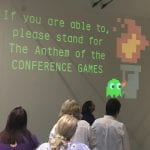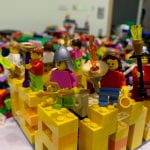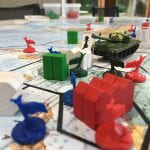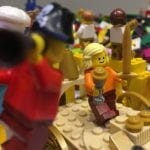Suzi read Playful learning: tools, techniques, and tactics by Nicola Whitton
This is a useful scene-setting article, suggesting ways of framing discussions on playful learning and pointing the way to unexplored territory suitable for future research.
There are three ideas about how to talk about playful learning:
- The magic circle – a socially constructed space in which play can happen
- A mapping of aspects of games onto playful learning: surface structures of playful learning <> mechanics of games, deep structures <> activities of play, implicit structure <> philosophy of playfulness
- Tools / techniques / tactics of playful learning: objects artefacts & technologies / approaches / mechanics and attributes – these could serve as prompts for getting playfulness into teaching
Whitton suggests three characteristics of the magic circle which make it pedagogically useful: “the positive construction of failure; support for learners to immerse themselves in the spirit of play; and the development of intrinsic motivation to engage with learning activities.” In playful activities, failure will be framed positively, participants suspend disbelief which can encourage creativity, and participation is voluntary so there is intrinsic motivation (the difficulty of this last in particular in a formal education setting is acknowledged).
There’s a lot of acknowledgement that playfulness may not be an easy fit in higher education. Obstacles include: the inescapably of real world power relationships, confusing gamification with true playfulness, the need for things to be mandatory and assessed, existing attitudes to failure, prejudice about play being for children, lack of time, confidence and social capital.
I wasn’t certain about the point about play being a privilege. While certain types of play might attract a relatively slender demographic (escape rooms, real world games) and it’s important not to assume that everyone would want to engage in these, adults seem to play to learn in a range of contexts. I thought about the kinds of spaces where you would see playful learning: cooking, Karaoke, parkour, getting dressed up, new social media platforms (when FB started and everyone was poking each other and and biting each other and throwing bananas, hashtags came from playing with the way Twitter worked), and of other adult pursuits. There is playfulness in higher education too, although it’s often not explicitly described as such. Maybe there is a danger of rarefying play and almost making it by definition a domain for geeks alone, not recognising play that has not been made explicit.
This got me thinking about why we play, and why we might want to play in HE, and about one of my favourite quotes:
“The things we want are transformative, and we don’t know or only think we know what is on the other side of that transformation. Love, wisdom, grace, inspiration – how do you go about finding these things that are in some ways about extending the boundaries of the self into unknown territory, about becoming someone else?”
— Rebecca Solnit, A field guide to getting lost
This sums up a lot of what university could and should be. Playfulness has to have a very key role in that: place to play with possible selves, both academic and social.
Chrysanthi read Gamifying education: what is known, what is believed and what remains uncertain: a critical review by Christo Dichev and Darina Dicheva.
This is a review aiming to find what is known about gamification in educational contexts based on empirical evidence, rather than beliefs. The authors seem to find that much more is believed or uncertain, rather than known. For example, their main findings are that a. gamification has started being used at a pace much faster than researchers pace at understanding how it works, b. there is very little knowledge about how to effectively apply it in specific contexts and c. there is not enough evidence about its benefit long term.
While the understanding of how to engage, motivate and aid learning through gamification is inadequate, researchers are still praising the practice, thus inflating expectations about its effectiveness. The frequent use of performance-centric game elements like points, levels, badges and leaderboards is noteworthy; in absence of justification from the researchers implementing them, the authors hypothesize that this happens because they are similar to traditional classroom practices and easy to implement. But this leaves other major game elements out; authors note – among others – role play, narrative, choice, low risk failure. These tiny elements are then expected to affect broad concepts like motivation, with researchers often concluding that that is the case, without enough evidence to claim it is so.
This implies a somewhat blind application of the easiest-to-implement elements of gamification, with the belief that it will be enough to motivate students to perform better. But how are points different to marks and levels different to grades and chapters?
Perhaps gamification can’t be a canned, one-size-fits-all-learning-contexts solutions. Perhaps researchers and practitioners need to put in time and at least a bare minimum of imagination to create something that will be engaging enough for students, for the evidence supporting it to not be stamped “inconclusive” when under scrutiny.
David read Playful learning in Higher Education: developing a signature pedagogy by Rikke Toft Nørgård, Claus Toft-Nielsen & Nicola Whitton (2017)
This paper starts off with a bit of a rant about the commercialisation of higher education and the focus on metrics to measure performance and how this creates an assessment-driven environment focused on goal-oriented behaviours characterised by avoidance of risk and fear of failure. The authors see recent gameful approaches in higher education as a response to this but warn that while gamification may increase motivation, games often focus on extrinsic motivational drivers and the results may be short-lived. They also cite research which points to issues around perceived appropriateness and students manipulating points-based incentive systems (and my colleagues and I have encountered examples of this in out teaching).
In contrast to gamification, they regard playful learning as something which encourages intrinsic and longer-term motivation by offering the chance to explore and experiment without fear of being judged for failure and therefore being able to learn from it. They use the ideas of the ‘magic circle’ and ‘lusory attitude’ to describe the environment in which this can occur. The concept of the magic circle is used a lot in gaming and is a metaphor for the ‘space’ we enter into when we fully engage with a game, accepting the different norms and codes of practice (or actively constructing them with other ‘players’). This can refer to physical (e.g. sports) or virtual/imaginary (e.g. computer games) or a combination of both (e.g. a child’s tea party). For this to work, we need to assume an ‘lusory attitude’. This gives participants a shared mindset in which they are free to play, experiment and fail in a safe place.
The Magic Circle – How Games Transport Us to New Worlds
The authors then turn to the question of how to implement such an approach. Using the results of two studies about what students report (a) makes their learning enjoyable and (b) disengages them, they develop a ‘signature pedagogy’ for playful learning in higher education. The notion of ‘signature pedagogy’ they assume is split into three levels:
- The foundation is formed by Implicit (playful) structures, which are the necessary assumptions and attitudes (values, habits, ethics)
- Lusory attitude
- Democratic values and openness
- Acceptance of risk-taking and failure
- Intrinsic motivation
- Deep (play) structures represent the nature of the activities which the implicit structures facilitate
- Active and physical engagement
- Collaboration with diverse others
- Imagining possibilities
- Novelty and surprise
- Surface (game) structures are the ‘mechanics’ of an activity, including the materials, tools and actions involved
- Ease of entry and explicit progression
- Appropriate and flexible levels of challenge
- Engaging game mechanics
- Physical or digital artefacts
The authors see the implicit (playful) structures as the necessary starting point for their ‘signature pedagogy’ but do not say how students get to this point. Indeed they acknowledge the inherent paradox in their model:
“…for many students to view learning as valuable then it must be valued by the system (assessed), yet it is simultaneously this assessment that makes learning stressful and undermines the creation of a safe and comfortable environment.”
For me, then, this article leaves three interrelated questions to be discussed:
- For playful learning to be successful, do students need to have the implicit structures already in place or can students acquire these through the playful activity itself?
- If these implicit structures are prerequisite, how do we get students to acquire them?
- As this involves a change in students’ attitudes which the authors argue are reinforced by the current assessment-driven environment, does this pedagogical approach have any chance of success without change at the programme or institutional level?
Suzanne read Unhappy families: using tabletop games as a technology to understand play in education by John Lean, Sam Illingworth, Paul Wake, published in the ALT Journal special issue
In this article, the authors decide to take a step back when considering the ‘future’ of digital technologies in relation to playful learning by considering traditional table top games as a form of technology. They aimed to better understand the affordances of digital game tools by looking at table top games as an analogue, in order to reflect critically on the pedagogical uses of games and playful learning. Their hypothesis was that table top games (see the article for a full definition of how they classify a game as ‘table top’), are successful because: 1) they provide an immediate and accessible shared space, which is also social; 2) this space and the game are both easily modified by players and educators; and 3) they provide a tactile, sensory experience. So, in essence, that they are social, modifiable and tactile, which are all things that could be transferred into digital games in education, but which are often overlooked.
To explore this hypothesis, they used a specific game, that of ‘Gloom‘, which was played by participants at the 2017 ALT Playful Learning Conference. In relation to the first hypothesis, they found that the game encouraged a lot of social interaction. Firstly, the game encourages players to talk about their recent lived experiences as a means of deciding who gets to go first (ie, who has had the worst day thus far). Additionally, there is a storytelling element of the game, which also encourages an empathetic interaction between the game and the players, as well as between players.
Regarding how modifiable the game is, the players found it was easy to change and adapt the game, even during play. They also explored the ways of playing around with and stretching the rules, to create different rules or games within the game play. The authors note that this is often not as easily achieved in digital games, where rules can be more fixed and more difficult to circumvent. Thirdly, the players did undoubtedly find the game tactile, as the cards provide a physical element, further enhanced by the way the cards are played. The cards themselves have transparent elements, so as you stack cards you create different versions of them, allowing for the storytelling element.
In conclusion, the authors used this game play experience to revisit some preconceptions about what ‘play’ or ‘playfulness’ is in a game context. They felt that the ‘true’ play seemed to happen when the players had modified the rules to the point where the game itself was almost no longer required. The players were exploring and testing their new game playfully, in the way that they were interacting with each other and the environment. In terms of education, they felt that this playfulness had great potential for learning. The process of negotiating the play, and working out how to play with others who might have different ideas to you (for example, either wanting to stick to the rules or wanting to break them) is potentially a powerful social learning opportunity.
However, they also noted that this very character of playful learning – that it is negotiated and created by the context and participants – makes it extremely difficult to categorise or understand pedagogically. If we need to allow for such variety of outcomes in playful learning, it can be difficult to work out how we can situate it within other educational structures, like lesson plans or learning objectives.
Suggested reading
- From the ALT Journal special issue
- Editorial: Playful Learning – A. Mark Langan, Fiona Smart
- Playful learning: tools, techniques, and tactics – Nicola Whitton
- Constraints and autonomy for creativity in extracurricular gamejams and curricular assessment – Simon Grey, David Parker, Neil Gordon
- Nostalgia, gamification and staff development – moving staff training away from didactic delivery – Tom Foster, Simon Warwick
- Using games to disrupt the conference Twittersphere – Rosie Jones, Emily Shields
- Unhappy families: using tabletop games as a technology to understand play in education – John Lean, Sam Illingworth, Paul Wake
- Playful learning in Higher Education: developing a signature pedagogy – Rikke Toft Nørgård, Claus Toft-Nielsen & Nicola Whitton
- Lameras (2015) Essential Features of Serious Games Design in Higher Education – https://www.srhe.ac.uk/downloads/LamerasEssential_Features_of_%20Serious_Games%20Design_Short_FINAL.pdf
- Martin, Lee (2015) “The Promise of the Maker Movement for Education,” Journal of Pre-College Engineering Education Research (J-PEER): Vol. 5: Iss. 1, Article 4. https://doi.org/10.7771/2157-9288.1099





